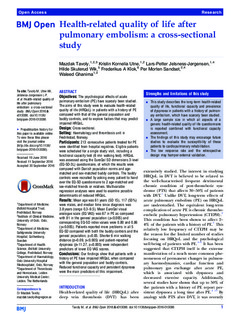| dc.description.abstract | Objectives The psychological effects of acute pulmonary embolism (PE) have scarcely been studied. The aims of this study were to evaluate health-related quality of life (HRQoL) in patients with a history of PE compared with that of the general population and buddy controls, and to explore factors that may predict impaired HRQoL.
Design Cross-sectional.
Setting Haematology and thrombosis unit in Fredrikstad, Norway.
Participants 213 consecutive patients treated for PE were identified from hospital registries. Eligible patients were scheduled for a single study visit, including a functional capacity test (6 min walking test). HRQoL was assessed using the EuroQol 5D dimensions 3-level (EQ-5D-3L) questionnaire, of which the results were compared with Danish population norms and age-matched and sex-matched buddy controls. The buddy controls were recruited by asking every patient to hand over the EQ-5D questionnaire to 2 age-matched and sex-matched friends or relatives. Multivariable regression analyses were used to examine possible determinants of reduced HRQoL.
Results Mean age was 61 years (SD 15), 117 (55%) were males, and median time since diagnosis was 3.8 years (range 0.3–9.5). Mean EuroQol visual analogue scale (EQ VAS) was 67 in PE as compared with 81 in the general population (p<0.005) and corresponding EQ-5D index values were 0.80 and 0.86 (p<0.005). Patients reported more problems in all 5 EQ-5D compared with both the buddy controls and the general population, p<0.05. Shorter 6 min walking distance (β=0.09, p<0.005) and patient-reported dyspnoea (β=11.27, p<0.005) were independent predictors of lower EQ VAS scores.
Conclusions Our findings show that patients with a history of PE have impaired HRQoL when compared with the general population and buddy controls. Reduced functional capacity and persistent dyspnoea were the main predictors of this impairment. | nb_NO |
